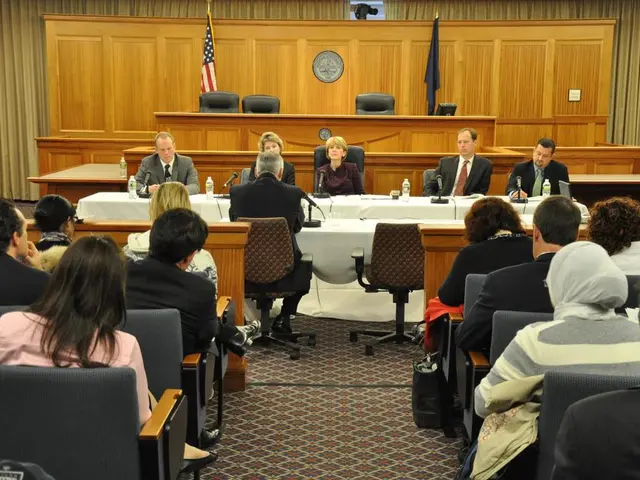Surveying Strategies for Polling Opinions and Elections: Best Approaches
In the lead-up to elections, choosing the right survey can significantly impact the results. Factors such as sample size, methodology, and past accuracy are crucial considerations.
Reliable opinion polling and election surveys depend on representative sampling, appropriate survey methods, well-designed questions, clear objectives, thorough testing, and addressing mode-specific biases and response challenges.
Representative Sampling is essential in ensuring every voice is heard. Random sampling gives every individual an equal chance, reducing bias. Stratified sampling ensures proportional representation of key demographic groups, such as age, race, and geography.
The choice of survey mode is also vital. Telephone polling, online surveys, and face-to-face interviews each have their advantages and disadvantages. Understanding the target demographic and context is key to making the right decision.
Clear and Focused Survey Design is crucial. Keep surveys concise (ideally under 12 minutes), use clear and concise language, and avoid double-barreled or confusing questions. Mobile-first survey design is also important for accessibility.
Question Construction Best Practices involve using balanced question scales, avoiding leading or loaded questions, and including opt-out options. Moderating the use of mandatory questions is also essential to respect respondents and encourage honest answers.
Testing and Validation are vital steps in the survey process. Pretest surveys with a small sample to identify and fix issues in wording, flow, and technical accessibility before full deployment.
Avoiding common pitfalls includes not relying on biased or unrepresentative samples, avoiding using poorly designed data collection tools, and clearly defining research questions and objectives upfront.
Using panel respondents can ensure quick replies and longitudinal tracking but risks non-representativeness due to frequent survey offers causing rushed or inattentive answers.
Surveys can shape perceptions by highlighting leading candidates or trending issues, potentially swaying undecided voters. The role of the margin of error in opinion polls is to indicate the level of uncertainty in results, helping interpret the accuracy and reliability of the findings.
When designing a survey, it should be simple, easy to understand, relevant to the target audience, and use closed-ended questions whenever possible. Survey data can guide messaging, target demographics, resource allocation, and issue prioritization for campaign strategy.
Election surveys are a way to collect data about people's opinions on various political issues. Social media data can be integrated into election surveys using social listening tools to identify emerging issues, voter sentiment trends, and online influence patterns.
Key elements of a reliable opinion poll include a representative sample size, unbiased questions, transparent methodology, and credible data analysis. Surveying voters before an election can help identify how the vote might swing.
A well-designed sample ensures that the survey reflects the demographics of the voting population, reducing bias. Reputable polling companies should be used to collect data, and surveys should be released at regular intervals.
Opinion polls are designed to represent the opinions of a population by providing statistical methods. By adopting global standards in sampling, methodology, transparency, and data analysis while adapting to local contexts, international best practices can be applied to Indian election polls.
By publishing full methodologies, sample details, funding sources, and data analysis techniques for public review, pollsters can ensure transparency in their surveys. Participants should be thanked for their time, and the survey should be kept short, no more than ten questions.
Opinion polls are surveys that gauge public opinion on a particular issue. They help campaigns understand voter priorities, measure candidate popularity, and adjust strategies based on real-time insights. The difference between opinion polls and exit polls is that opinion polls are conducted before voting takes place, while exit polls are conducted immediately after voters have cast their ballots.
Limitations of opinion polls in predicting election outcomes include changing voter sentiment, inaccurate self-reporting, and unexpected turnout patterns. Election surveys can gauge public opinion on various topics, from the economy to national security.
The survey should be kept short, avoid leading questions, be transparent about how data is used, keep track of who has participated in the survey, and remove them from subsequent surveys. There is a difference between quantitative and qualitative election research, with quantitative research using numerical data to measure trends, while qualitative research focuses on in-depth opinions and motivations.
One way to get in touch for help with a polling project is by filling out the online form on the website or giving a call at 91 9848321284.
- Surveys can be beneficial for education-and-self-development purposes, as they help gather opinions on various topics, such as learning preferences or feedback on education resources.
- In the realm of general-news reporting, surveys can be utilized to understand public sentiment towards current affairs, assisting journalists in framing news stories that resonate with their audience.
- Social media analytics can complement election surveys by providing insights into online political conversations and identifying influential voices that may have a significant impact on campaign strategy and social media engagement.
- Blog writers could utilize survey data to tailor their content, ensuring it addresses the interests and preferences of their readership for increased engagement and viewership.




